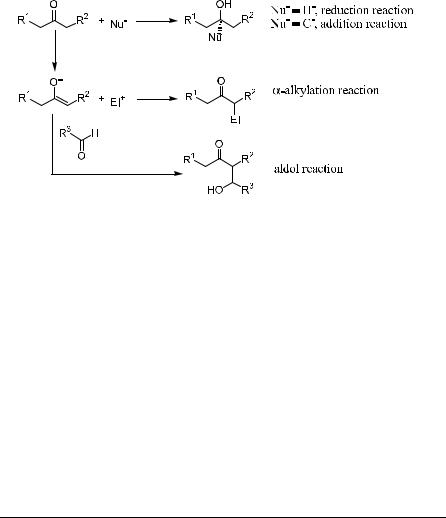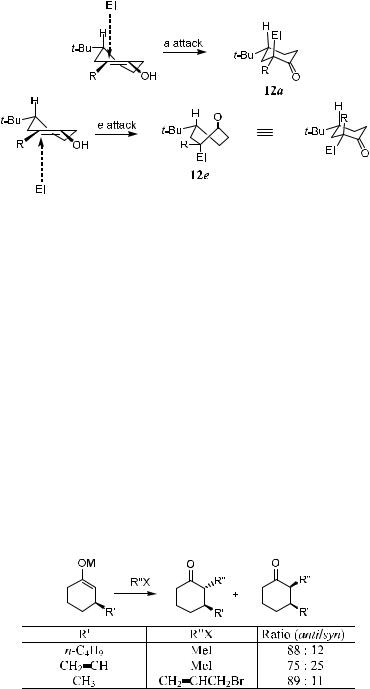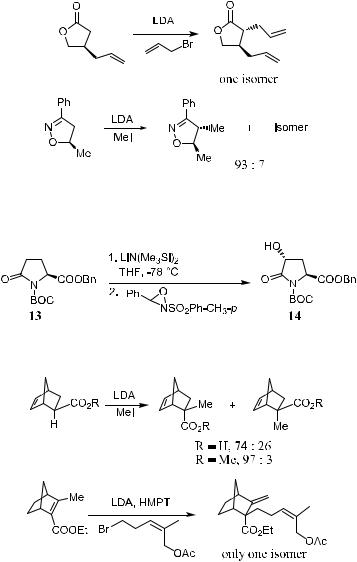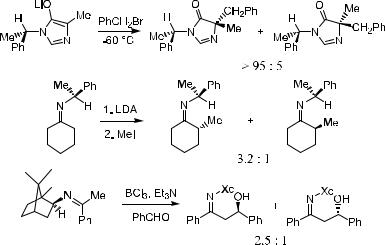
Principles and Applications of Asymmetric Synthesis
.pdf1.8 REFERENCES 69
in Sammes, P. G. ed. Top. Antibiotic Chem., Wiley, New York, 1977, vol. 1, p 91.
(d) Harada, T.; Kagamihara, Y.; Tanaka, S.; Sakamoto, K.; Oku, A. J. Org. Chem. 1992, 57, 1637.
92.Rychnovsky, S. D.; Rodriguez, C. J. Org. Chem. 1992, 57, 4793.
93.(a) Nicolaou, K. C.; Kubota, S.; Li, W. S. J. Chem. Soc. Chem. Commun. 1989 512. (b) Colombo, M. I.; Zinczuk, J.; RuveÂda, E. A. Tetrahedron 1992, 48, 963.
94.(a) Bormans, B. Chem. Eng. News 1991, 69, Sep 2, 11. (b) GueÂnard, D.; GueÂritteVoegelein, F.; Potier, P. Acc. Chem. Res. 1993, 26, 160. (c) Denis, J.; Greene, A. E.; GueÂnard, D.; GueÂritte-Voegelein, F.; Mangatal, L.; Potier, P. J. Am. Chem. Soc. 1988, 110, 5917. (d) Flam, F. Science 1994, 263, 911. (e) Nicolaou, K. C.; Dai, W. M.; Guy, R. K. Angew. Chem. Int. Ed. Engl. 1994, 33, 15. (f ) Wang, Z. M.; Kolb, H. C.; Sharpless, K. B. J. Org. Chem. 1994, 59, 5104.
95.(a) Armstrong, R. W.; Beau, J. M.; Cheon, S. H.; Christ, W. J.; Fujioka, H.; Ham, W. H.; Hawkins, L. D.; Jin, H.; Kang, S. H.; Kishi, Y.; Martinelli, M. J.; McWhorter, W. W.; Mizuno, M.; Nakata, M.; Stutz, A. E.; Talamas, F. X.; Taniguchi, M.; Tino, J. A.; Ueda, K.; Uenishi, J.; White, J. B.; Yonaga, M. J. Am. Chem. Soc. 1989, 111, 7530. (b) Cha, J. K.; Christ, W. J.; Finan, J. M; Kishi, Y.; Klein, L. L.; Ko, S. S.; Leder, J.; McWhorter, W. W.; Pfa¨, K.-P.; Yonaga, M.
J. Am. Chem. Soc. 1982, 104, 7369.
96.Napier, M. A.; Holmquist, B.; Strydom, D. J.; Goldberg, I. H. Biochem. Biophys. Res. Commun. 1979, 89, 635.
97.Konishi, M.; Ohkuma, H.; Saitoh, K.; Kawaguchi, H.; Golik, J.; Dubay, G.; Groenewold, G.; Krishnan, B.; Doyle, T. W. J. Antibiot. 1985, 38, 1605.
98.Lee, M. D.; Dunne, T. S.; Siegel, M. M.; Chang, C. C.; Morton, G. O.; Borders, D. B. J. Am. Chem. Soc. 1987, 109, 3464.
99.Konishi, M.; Ohkuma, H.; Matsumoto, K.; Tsuno, T.; Kamei, H.; Miyaki, T.; Oki, T.; Kawaguchi, H.; VanDuyne, G. D.; Clardy, J. J. Antibiot. 1989, 42, 1449.
100.For a review, see Nicolau, N. C.; Dai, W. M. Angew. Chem. Int. Ed. Engl. 1991, 30, 1387.
101.Nicolaou, K. C.; Clark, D. Angew. Chem. Int. Ed. Engl. 1992, 31, 855.
102.Leet, J. E.; Schroeder, D. R.; Hofstead, S. J.; Golik, J.; Colson, K. L.; Huang, S.; Klohr, S. E.; Doyle, T. W.; Matson, J. A. J. Am. Chem. Soc. 1992, 114, 7946.
103.Nicolaou, K. C.; Hummel, C. W.; Pitsinos, E. N.; Nakada, M., Smith, A. L.; Shibayama, K.; Saimoto, H. J. Am. Chem. Soc. 1992, 114, 10082.
104.(a) Romo, D.; Johnson, D. D.; Plamondon, L.; Miwa, T.; Schreiber, S. L. J. Org. Chem. 1992, 57, 5060. (b) Romo, D.; Meyer, S. D.; Johnson, D. D. Schreiber, S. L.
J. Am. Chem. Soc. 1993, 115, 7906.
105.Tanaka, H.; Kuroda, A.; Marusawa, H.; Hatanaka, H.; Kino, T.; Goto, T.; Hashimoto, M.; Taga, T. J. Am. Chem. Soc. 1987, 109, 5031.
106.(a) Villalobos, A.; Danishefsky, S. J. J. Org. Chem. 1990, 55, 2776. (b) Jones, T. K.; Mills, S. G.; Reamer, R. A.; Askin, D.; Desmond, R.; Volante, R. P.; Shinkai, I. J. Am. Chem. Soc. 1989, 111, 1157. (c) Jones, T. K.; Reamer, R. A.; Desmond, R.; Mills, S. G. J. Am. Chem. Soc. 1990, 112, 2998. (d) Nakatsuka, M.; Ragan, J. A.; Sammakia, T.; Smith, D. B.; Uehling, D. E.; Schreiber, S. L. J. Am. Chem. Soc. 1990, 112, 5583.

Principles and Applications of Asymmetric Synthesis
Guo-Qiang Lin, Yue-Ming Li, Albert S.C. Chan
Copyright ( 2001 John Wiley & Sons, Inc.
ISBNs: 0-471-40027-0 (Hardback); 0-471-22042-6 (Electronic)
 CHAPTER 2
CHAPTER 2
a-Alkylation and Catalytic Alkylation of
Carbonyl Compounds
Chapter 1 introduced the nomenclature for chiral systems, the determination of enantiomer composition, and the determination of absolute con®guration. This chapter discusses di¨erent types of asymmetric reactions with a focus on asymmetric carbon±carbon bond formation. The asymmetric alkylation reaction constitutes an important method for carbon±carbon bond formation.
2.1INTRODUCTION
The carbonyl group in a ketone or aldehyde is an extremely versatile vehicle for the introduction of functionality. Reaction can occur at the carbonyl carbon atom using the carbonyl group as an electrophile or through enolate formation upon removal of an acidic proton at the adjacent carbon atom. Although the carbonyl group is an integral part of the nucleophile, a carbonyl compound can also be considered as an enophile when involved in an asymmetric ``carbonylene'' reaction or dienophile in an asymmetric hetero Diels-Alder reaction. These two types of reaction are discussed in the next three chapters.
The prime functional group for constructing C±C bonds may be the carbonyl group, functioning as either an electrophile (Eq. 1) or via its enolate derivative as a nucleophile (Eqs. 2 and 3). The objective of this chapter is to survey the issue of asymmetric inductions involving the reaction between enolates derived from carbonyl compounds and alkyl halide electrophiles. The addition of a nucleophile toward a carbonyl group, especially in the catalytic manner, is presented as well. Asymmetric aldol reactions and the related allylation reactions (Eq. 3) are the topics of Chapter 3. Reduction of carbonyl groups is discussed in Chapter 4.
71

72 a-ALKYLATION AND CATALYTIC ALKYLATION OF CARBONYL COMPOUNDS
(1)
(2)
(3)
Carbonyl compounds including ketones, aldehydes and carboxylic acid derivatives constitute a class of carbon acids, the acidity of which falls in the pKa range of 25 to 35 in dimethylsulfoxide (DMSO). Representative values for selected carbonyl substrates are summarized in Table 2±1.1 Di¨erent methods may be invoked for generating the enolates according to the pKa value of their parent compounds.
To generate an enolate from a carbonyl substrate, a suitable base should be chosen to meet two criteria:
1.Adequate basicity to ensure the selective deprotonation process for enolate generation
2.A sterically hindered structure so that nucleophilic attack of this base on the carbonyl centers can be prevented.
TABLE 2±1. pKa Data for Representative Carbonyl Compounds and Related Substances in DMSO
Substrate |
pKa (DMSO) |
Substrate |
pKa (DMSO) |
H3CCOCH3 |
26.5 |
NCCH3 |
31.3 |
PhCOCH3 |
24.6 |
EtOCOCH3 |
30±31 |
PhCOCH2CH3 |
24.4 |
EtOCOCH2Ph |
22.7 |
PhCOCH2OMe |
22.9 |
EtOCOCH2SPh |
21.4 |
PhCOCH2Ph |
17.7 |
Me2NCOCH3 |
34±35 |
PhCOCH2SPh |
17.1 |
CH3SOCH3 |
35.1 |
HOH |
27.5 |
NH3 |
41 |
CH3OH |
27.9 |
HN(CH3)2 |
44 |
(CH3)2CHOH |
29.3 |
(CH3)3COH |
29.4 |
Reprinted with permission by Am. Chem. Soc., Ref. 1(a).

2.2 CHIRALITY TRANSFER |
73 |
The metal amide bases had enjoyed much popularity since the introduction of sterically more hindered bases 1±4. The introduction of sterically hindered bases 1±4 has been a particularly important innovation in this ®eld, and these reagents have now been accepted as the most suitable and commonly used bases for carbonyl deprotonation. The metal dialkylamides are all quite soluble in ethereal solvent systems. Lithium diisopropylamide (LDA, 1)2 has been recognized as the most important strong base in organic chemistry. Both LDA (1) and lithium isopropylcyclohexyl amide (LICA 2)3 exhibit similarly high kinetic deprotonation selectivity. Furthermore, silylamides 4a±c have been found to exhibit good solubility in aromatic hydrocarbon solvents,4 and these silyl amides are comparably e¨ective in enolate generation. In fact, lithium tetramethylpiperidine (LTMP 3)5 is probably the most sterically hindered amide base at this time.
Before the emergence in the mid-1980s of the asymmetric deprotonation of cis±dimethyl cyclohexanone using enantiomerically pure lithium amide bases, few reports pertaining to the chemistry of these chiral reagents appeared. Although it is not the focus of this chapter, the optically active metal amide bases are still considered to be useful tools in organic synthesis. Readers are advised to consult the appropriate literature on the application of enantiomerically pure lithium amides in asymmetric synthesis.6
2.2CHIRALITY TRANSFER
The asymmetric alkylation of a carbonyl group is one of the most commonly used chirality transfer reactions. The chirality of a substrate can be transferred to the newly formed asymmetric carbon atom through this process. In surveying chiral enolate systems as a class of nucleophile, three general subdivisions can be made in such asymmetric nucleophilic addition reactions: intra-annular, extra-annular, and chelation enforced intra-annular.
Considering enolate 5, where X, Y, and Z stand for three connective points for cyclic enolate formation, the formation can occur between any two of such points, leading to three possible oxygen enolates: endo-cyclic 6, 7, and exocyclic enolate 8. In such cases, the resident asymmetric center (*) may be positioned on any connective atom in the substrate.

74 a-ALKYLATION AND CATALYTIC ALKYLATION OF CARBONYL COMPOUNDS
These classes of enolates are central to our discussion of chirality transfer and thus are brie¯y discussed in the following sections.
2.2.1Intra-annular Chirality Transfer
The de®nition of intra-annular chirality transfer can be best established by the following examples (Scheme 2±1)7:
Scheme 2±1. Intra-annular chirality transfer.
The examples in Scheme 2±1 show that in intra-annular chirality transfer the resident asymmetric center connects to the enolate through annular covalent bonds. The geometric con®guration of the enolate can be either immobile or irrelevant to the sense of asymmetric induction.
2.2.1.1 Six-Membered Ring (exo-Cyclic). The diastereoselective alkylation reactions of exo-cyclic enolates involving 1,2-asymmetric inductions are antiinductions. In Scheme 2±2, there are two possible enolate chair conformations in which the two possible transition-state geometries lead to the major diastereomer 9e (where the substituent takes the equatorial orientation). However, for the case in which R ˆ methyl and X ˆ alkoxyl or alkyl, one would expect the

2.2 CHIRALITY TRANSFER |
75 |
|||
|
|
|
|
|
|
|
|
|
|
|
|
|
|
|
|
|
|
|
|
|
|
|
|
|
Scheme 2±2. Two possible enolate chair conformations.
axial conformation 9a to be favored over the equatorial conformation 9e. As shown in Scheme 2±2, 9e su¨ers from the steric strain R $ X(OM), and 9a is more likely to be favored to receive axial attack by the approaching electrophile rather than the less stable enolate 9e by the equatorial attack.8
Examples are given in Scheme 2±3. Enolate 10 exhibits selective alkylation anti to the alkyl substituent, and the same anti-induction occurs in the case of 1,4-asymmetric induction of 11.9
2.2.1.2 Six-Membered Ring (endo-Cyclic). All the previous discussion of stereo-attack is based on steric hindrance, but in the case of a six-membered ring (endo-cyclic) enolate, the direction is a¨ected simultaneously by stereoelectronic e¨ects (Scheme 2±4).10 In the transition state, the attacking electrophiles must obey the principle of maximum overlap of participating orbitals by perpendicularly approaching the plane of atoms that constitute the enolate functional group. Electrophile attacks take place on the two diastereotopic
Scheme 2±3. Alkylation of exo-cyclic six-membered ring substrates.

76 a-ALKYLATION AND CATALYTIC ALKYLATION OF CARBONYL COMPOUNDS
Scheme 2±4. Transition states of the endo-cyclic six-membered ring.
faces of the enolate, the a attack and the e attack, which lead to the ketone products 12a and 12e. Ketone 12a, obtained via a postulated chair-like transition state, could be presumed to be formed in preference to ketone 12e, which resulted from a boat-like transition state. The energetic bias for ``axial alkylation'' via a chair-like transition state to form 12a is relatively small.11 Therefore, for a given enolate, the ratio 12a:12e is insensitive to the alkylating agent employed.
Scheme 2±5 is one of such examples in which stereoelectronic control has to be taken into account in diastereoselective alkylation of substituted cyclohexanone enolates.12
The diastereoselective alkylation reaction of endo-cyclic ®ve-membered ring enolates exhibits good potential for both 1,3- and 1,2-asymmetric induction. In Scheme 2±6, the factor controlling the alkylation transition state is steric rather than stereoelectronic, leading to an anti-induction.13
The reaction shown in Scheme 2±7 is an example of 1,3-asymmetric induction. The oxidative hydroxylation of a ®ve-membered lactone led to an a- hydroxyl product 14.14 The a-hydroxylation of carbonyl compounds is further discussed in Chapter 4.
Scheme 2±5. Alkylation of endo-cyclic six-membered ring systems.

2.2 CHIRALITY TRANSFER |
77 |
Scheme 2±6. Reaction for a ®ve-membered ring system.
Scheme 2±7. Oxidative hydroxylation.
Scheme 2±8. Diastereoselective alkylation reactions in the norbornyl ring system.
There are also many examples of alkylation reactions involving the norbornyl ring system in which the enolate can be either endoor exo-cyclic. Both the endo-cyclic (6, 7) and exo-cyclic (8) enolates exhibit high levels of asymmetric induction due to the rigid ring system. Scheme 2±8 presents some examples for alkylation involving the norbornyl ring system.15

78 a-ALKYLATION AND CATALYTIC ALKYLATION OF CARBONYL COMPOUNDS
2.2.2Extra-annular Chirality Transfer
The cases illustrated here are typical examples of extra-annular chirality transfer via the alkylation process (Scheme 2±9)16:
Scheme 2±9. Extra-annular chirality transfer. Xc stands for the chiral auxiliary.
One can see from the examples in Scheme 2±9 that, although the asymmetric center thus formed connects to the enolate through a covalent bond, the stereorelationship between the chirality transfer and the enolate cannot be established because the resident chiral moiety is not conformationally ®xed at two or more contact points via covalent bonds to the trigonal center undergoing substitution. As a consequence of this conformational ¯exibility, it is frequently di½cult to make the desired prediction for stereoselectivity. Nonetheless, with an increasing understanding of acyclic conformational analysis, particularly the implications of ring strain or steric hindrance, greater acyclic diastereoselectivity is achievable.17 Scheme 2±10 provides two further examples of extra-annular chirality transfer.18,19
In Eq. 1, lithium enolate generated from tetronic acid±derived vinylogous urethanes undergoes alkylation with an electrophile to give a product with a diastereoselectivity of 97:3. Eq. 2 in Scheme 2±10 is a diastereoselective conjugate addition reaction. When treated with organocopper reagents, compound 15 undergoes reactions with high diastereoselectivity.19 Asymmetric conjugate addition is further discussed in Chapter 8.
Examination of di¨erent molecular models shows that the bicyclic nature of 15 creates a rigid molecule where steric hindrance plays a predominant role. This can help explain the high enantioselectivity for the product.

2.2 CHIRALITY TRANSFER |
79 |
Scheme 2±10. Two examples of extra-annular chirality transfer.
TABLE 2±2. Reaction of 15 With Various Reagents
|
Me2CuLi |
Bu2CuLi |
Ph2CuLi |
(EtCHbCH)2CuLi |
Yield |
85 |
90 |
84 |
80 |
ee |
94(S) |
95(S) |
96(R) |
90(R)* |
|
|
|
|
|
* This inversion of con®guration is only due to the CIP selection rules and does not correspond to the steric course of the reaction.
2.2.3Chelation-Enforced Intra-annular Chirality Transfer
As a result of the combination of intraand extra-annular chirality transfer, a productive approach has been developed for the design of chiral enolate systems in which a structurally organized diastereofacial bias is established, as illustrated in the equations in Scheme 2±11. A lithium-coordinated ®vemembered or six-membered ring ®xes the orientation between the inducing asymmetric center and the enolate20:
Thus, the postulated chelated enolates and their alkylation reaction make the intra-annular chirality transformation possible. This method for enolate formation is the focal point of this chapter, as this is by far the most e¨ective approach to alkylation or other asymmetric synthesis involving carbonyl are compounds.
